2013 Peugeot 807 ABS
[x] Cancel search: ABSPage 4 of 234

2
Contents
4. SAFETY 85-102
Driving safety 86
Handbrake 86
Hazard warning lights 86
Parking assistance 87
ABS and EBFD 88
Horn 88
Emergency braking
assistance 88
ASR and ESP 89
Tyre under-infl ation
detection 90
Seat belts 91
Airbags 93
Passenger air bag
disarming 93
Child seats 97
Isofi x seats 99
Recommended seats 100
Monitoring mirror 102 Steering wheel
controls 43
Lighting 43
Windscreen wipers 46
Cruise control 48
Speed limiter 51
Ventilation 54
De-icing and demisting 55
Seats 59
Front 59
Rear 64
Bench seat 69
Modularity 71
Comfort and safety 75
Layout 75
Courtesy lights 80
Sun visor 81
Mirrors and windows 82
3. EASE OF USE and
COMFORT 43-84
Presentation 4
Communication 4
Exterior 6
Interior 8
Identifi cation features 17
1. FAMILIARISATION 4-17
Accesses 18
Keys 18
Alarm 22
Doors 23
Child safety 25
Tailgate 25
Sunroofs 26
Instruments and controls 27
Control block 27
Instrument panels 28
Warning lights 29
Indicators, Display 34
Gearbox
Automatic 37
Manual 41
Steering
wheel adjustment 41
Starting and stopping 42
2. READY
TO SET OFF 18-42
Page 31 of 234

Instruments and controls
READY TO SET OFF
2
29
WARNING LIGHTS
Each time the engine is started: a series of warning lights comes on applying a self-test check. They switch off almost
immediately. With the engine running: the warning light becomes a warning if it remains on continuously or fl ashes. This
initial warning may be accompanied by an audible signal and a message which appears on the display. "Do not ignore
these warnings."
Warning light is indicates Solution - action
STOP
lit, associated
with another
warning
light and
accompanied
by a message
on the display. major faults linked with the
"Brake fl uid level", "Engine
oil pressure", "Coolant
temperature", "Electronic
brake force distribution",
"Power steering" and
"Punctured tyre" warning
lights.
You must stop, park, switch off the ignition
and call a PEUGEOT dealer.
Handbrake/
Brake fl uid
level/EBFD
lit. handbrake applied or not
released correctly. Releasing the handbrake switches off the warning
light. Chapter 2, "Starting and stopping" section.
lit. low brake fl uid level. Top up using a fl uid recommended by PEUGEOT.
remaining on,
even though the
level is correct and
associated with the
ABS warning light.
failure of the electronic
brake force distribution.
You must stop, park, switch off the ignition
and call a PEUGEOT dealer.
Engine oil
pressure
lit while driving. insuffi cient pressure. Park, switch off the ignition and allow to cool.
Visually check the level. Chapter 6, "Levels"
section.
remaining on,
even though
the level is
correct. major fault. Call a PEUGEOT dealer.
Page 33 of 234
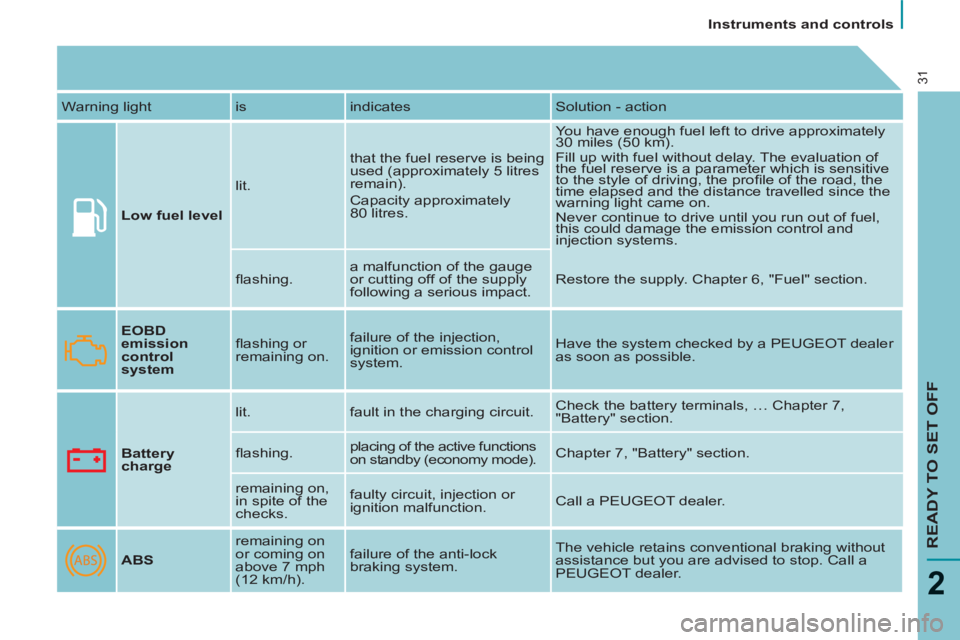
Instruments and controls
READY TO SET OFF
2
31
Warning light is indicates Solution - action
Low fuel level
lit. that the fuel reserve is being
used (approximately 5 litres
remain).
Capacity approximately
80 litres. You have enough fuel left to drive approximately
30 miles (50 km).
Fill up with fuel without delay. The evaluation of
the fuel reserve is a parameter which is sensitive
to the style of driving, the profi le of the road, the
time elapsed and the distance travelled since the
warning light came on.
Never continue to drive until you run out of fuel,
this could damage the emission control and
injection systems.
fl ashing. a malfunction of the gauge
or cutting off of the supply
following a serious impact. Restore the supply. Chapter 6, "Fuel" section.
EOBD
emission
control
system
fl ashing or
remaining on. failure of the injection,
ignition or emission control
system. Have the system checked by a PEUGEOT dealer
as soon as possible.
Battery
charge
lit. fault in the charging circuit. Check the battery terminals, … Chapter 7,
"Battery" section.
fl ashing. placing of the active functions
on standby (economy mode). Chapter 7, "Battery" section.
remaining on,
in spite of the
checks. faulty circuit, injection or
ignition malfunction. Call a PEUGEOT dealer.
ABS
remaining on
or coming on
above 7 mph
(12 km/h). failure of the anti-lock
braking system. The vehicle retains conventional braking without
assistance but you are advised to stop. Call a
PEUGEOT dealer.
Page 77 of 234
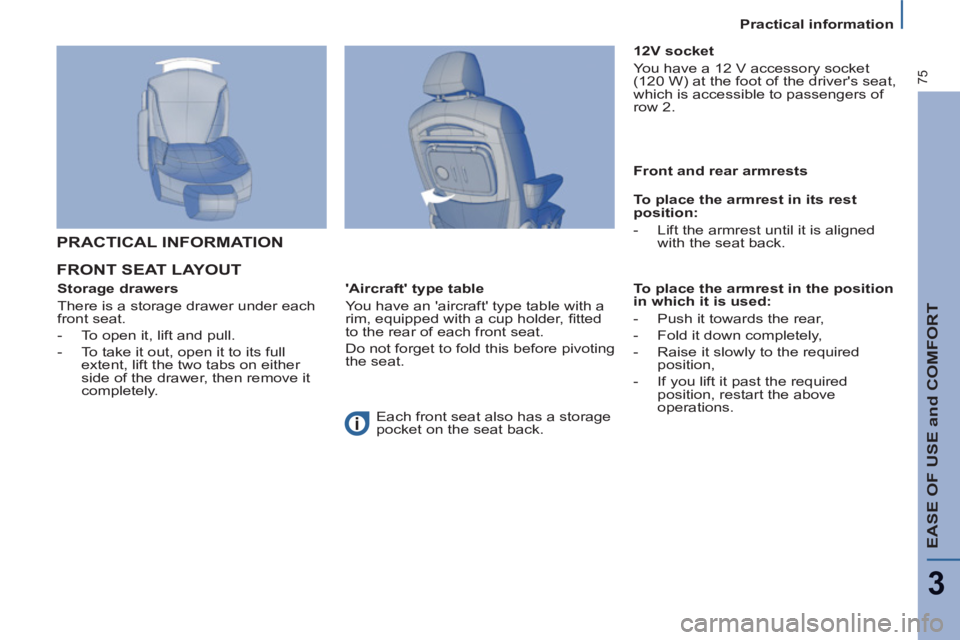
EASE OF USE and COMFORT
3
75
Practical information
FRONT SEAT LAYOUT
Storage drawers
There is a storage drawer under each
front seat.
- To open it, lift and pull.
- To take it out, open it to its full
extent, lift the two tabs on either
side of the drawer, then remove it
completely.
PRACTICAL INFORMATION
'Aircraft' type table
You have an 'aircraft' type table with a
rim, equipped with a cup holder, fi tted
to the rear of each front seat.
Do not forget to fold this before pivoting
the seat.
12V socket
You have a 12 V accessory socket
(120 W) at the foot of the driver's seat,
which is accessible to passengers of
row 2.
Front and rear armrests
To place the armrest in its rest
position:
- Lift the armrest until it is aligned
with the seat back.
Each front seat also has a storage
pocket on the seat back.
To place the armrest in the position
in which it is used:
- Push it towards the rear,
- Fold it down completely,
- Raise it slowly to the required
position,
- If you lift it past the required
position, restart the above
operations.
Page 83 of 234
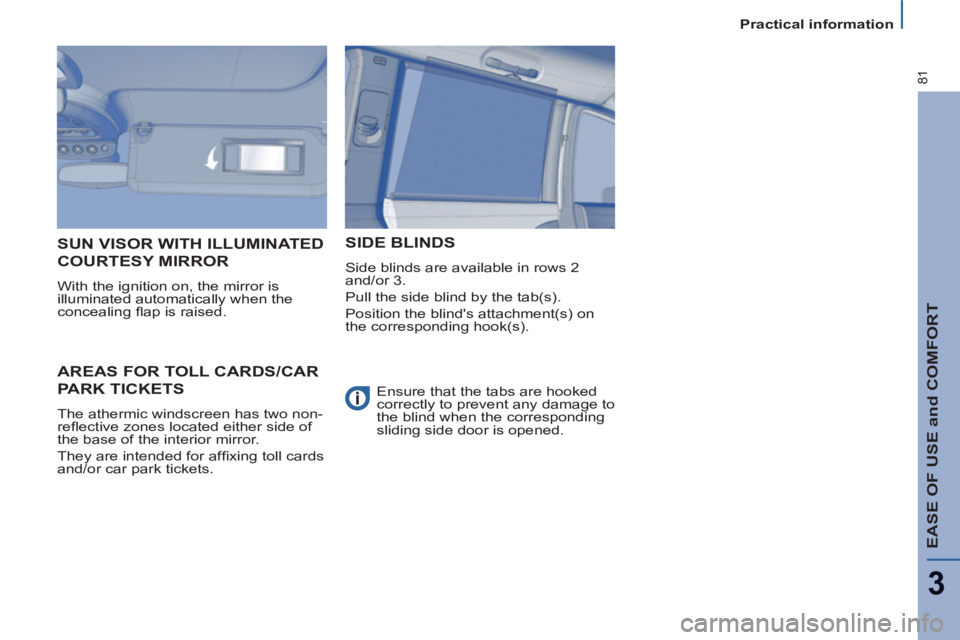
EASE OF USE and COMFORT
3
81
Practical information
AREAS FOR TOLL CARDS/CAR
PARK TICKETS
The athermic windscreen has two non-
refl ective zones located either side of
the base of the interior mirror.
They are intended for affi xing toll cards
and/or car park tickets.
SUN VISOR WITH ILLUMINATED
COURTESY MIRROR
With the ignition on, the mirror is
illuminated automatically when the
concealing fl ap is raised.
SIDE BLINDS
Side blinds are available in rows 2
and/or 3.
Pull the side blind by the tab(s).
Position the blind's attachment(s) on
the corresponding hook(s).
Ensure that the tabs are hooked
correctly to prevent any damage to
the blind when the corresponding
sliding side door is opened.
Page 87 of 234
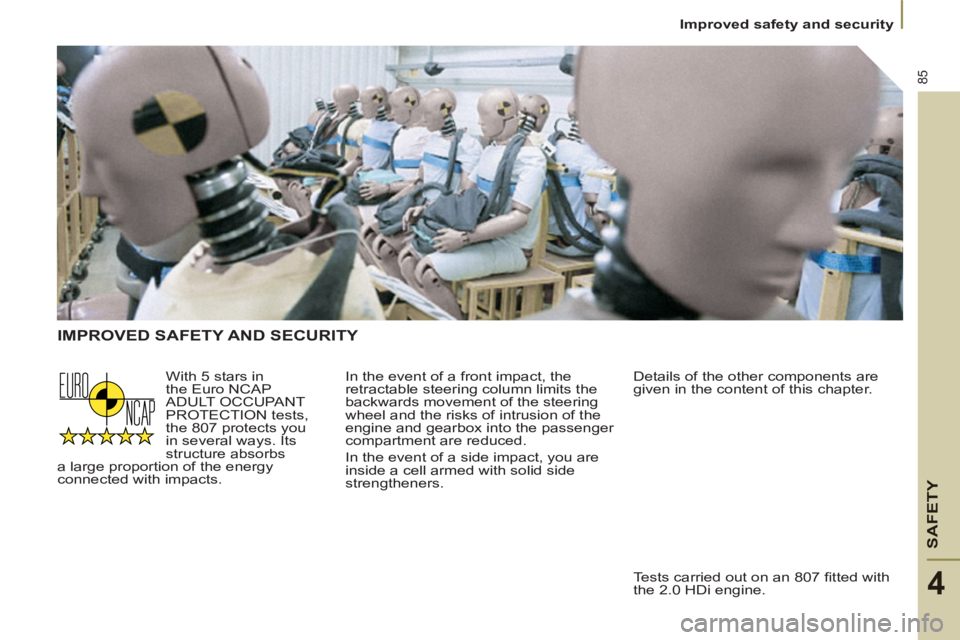
SAFETY
85
Improved safety and security
4
IMPROVED SAFETY AND SECURITY
In the event of a front impact, the
retractable steering column limits the
backwards movement of the steering
wheel and the risks of intrusion of the
engine and gearbox into the passenger
compartment are reduced.
In the event of a side impact, you are
inside a cell armed with solid side
strengtheners. With 5 stars in
the Euro NCAP
ADULT OCCUPANT
PROTECTION tests,
the 807 protects you
in several ways. Its
structure absorbs
a large proportion of the energy
connected with impacts.
Tests carried out on an 807 fi tted with
the 2.0 HDi engine.
Details of the other components are
given in the content of this chapter.
Page 90 of 234
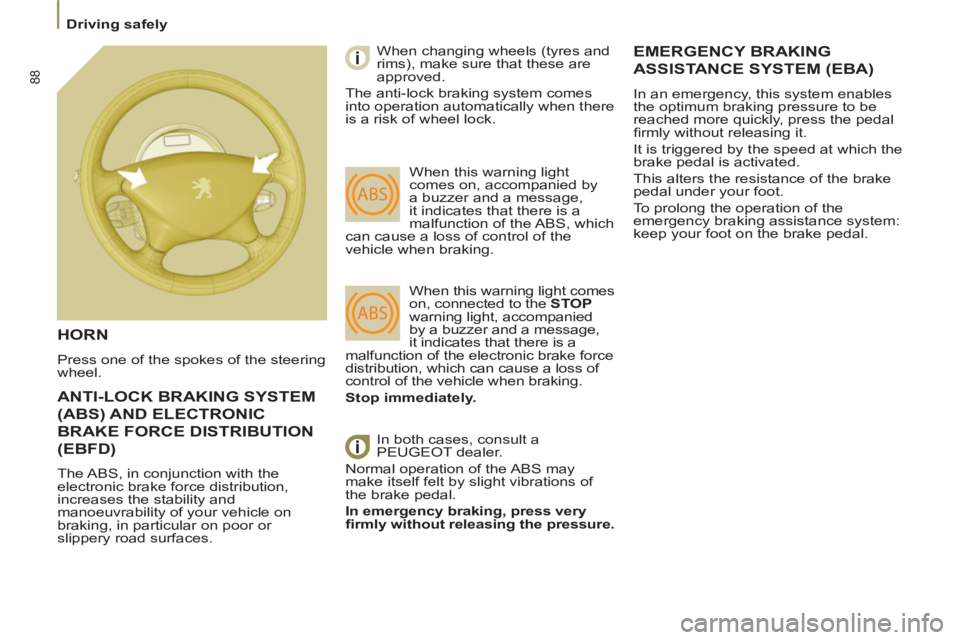
88
Driving safely
ANTI-LOCK BRAKING SYSTEM
(ABS) AND ELECTRONIC
BRAKE FORCE DISTRIBUTION
(EBFD)
The ABS, in conjunction with the
electronic brake force distribution,
increases the stability and
manoeuvrability of your vehicle on
braking, in particular on poor or
slippery road surfaces.
HORN
Press one of the spokes of the steering
wheel. When changing wheels (tyres and
rims), make sure that these are
approved.
The anti-lock braking system comes
into operation automatically when there
is a risk of wheel lock.
When this warning light
comes on, accompanied by
a buzzer and a message,
it indicates that there is a
malfunction of the ABS, which
can cause a loss of control of the
vehicle when braking.
When this warning light comes
on, connected to the STOP
warning light, accompanied
by a buzzer and a message,
it indicates that there is a
malfunction of the electronic brake force
distribution, which can cause a loss of
control of the vehicle when braking.
Stop immediately.
In both cases, consult a
PEUGEOT dealer.
Normal operation of the ABS may
make itself felt by slight vibrations of
the brake pedal.
In emergency braking, press very
fi rmly without releasing the pressure.
EMERGENCY BRAKING
ASSISTANCE SYSTEM
(EBA)
In an emergency, this system enables
the optimum braking pressure to be
reached more quickly, press the pedal
fi rmly without releasing it.
It is triggered by the speed at which the
brake pedal is activated.
This alters the resistance of the brake
pedal under your foot.
To prolong the operation of the
emergency braking assistance system:
keep your foot on the brake pedal.
Page 91 of 234

SAFETY
89
Driving safely
4
TRACTION CONTROL (ASR)
AND DYNAMIC STABILITY
CONTROL
(ESP)
Activation of the ASR and ESP
systems
When the ignition is on, the ASR and
ESP systems are always active.
Disarming the ASR/ESP
systems
In certain conditions (vehicle stuck in
mud or snow, or on loose ground...), it
could prove useful to disarm the ASR
and ESP systems to make the wheels
spin and regain grip.
�)
Press the switch, situated under
the steering wheel on the left of the
fascia.
The indicator light comes on
accompanied by a message:
the ESP and ASR systems
no longer act on the engine
operation, but continue to act
on the brakes.
Operating check
The ASR/ESP systems offer
increased safety during normal
driving, but should not incite the
driver to take risks or to drive at high
speed.
The operation of these systems is
ensured if the recommendations
of the manufacturer regarding
the wheels (tyres and rims), the
braking components, the electronic
components and the fi tting and repair
procedures within the PEUGEOT
network are observed.
After an impact, have these systems
checked by a PEUGEOT dealer.
They engage again:
�)
automatically above 30 mph
(50 km/h),
�)
manually by pressing the switch
again.
Operation of the ASR and
ESP systems
The warning light fl ashes if
the ASR or ESP is activated.
These systems are linked and
complement the ABS.
The ASR system optimises drive to
prevent the wheels skidding, by acting
on the brakes of the drive wheels
and on the engine. It also allows the
directional stability of the vehicle to be
improved on acceleration.
If there is a variation between the
trajectory followed by the vehicle and
that required by the driver, the ESP
system automatically acts on the
engine and the brake of one or more
wheels, in order to put the vehicle back
on course, within the limits of the laws
of physics. When a malfunction of the
systems occurs, the indicator
light comes on, accompanied
by an audible signal and a
message on the display.
Consult a PEUGEOT dealer to have
the system checked.